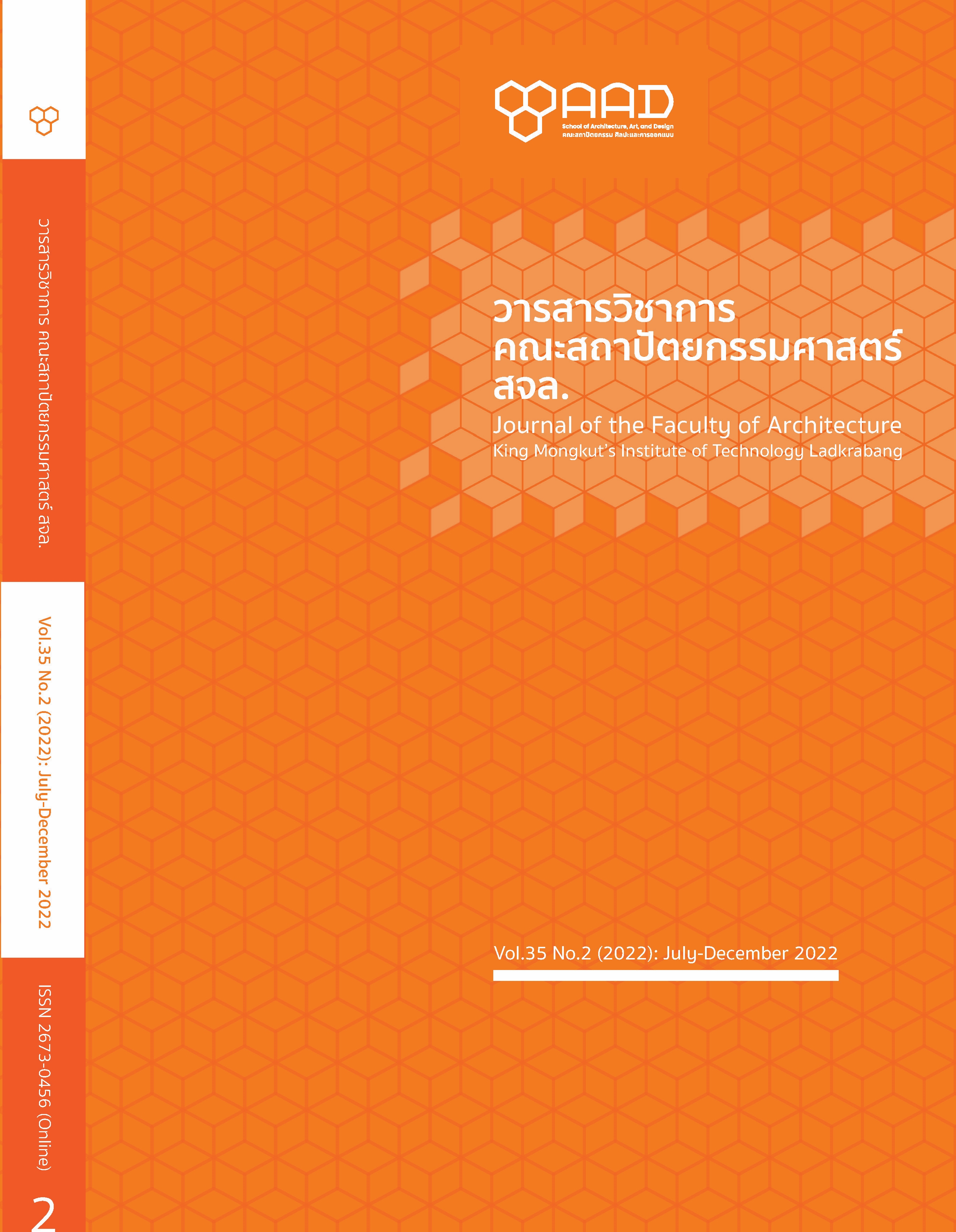การออกแบบพื้นที่การเรียนรู้คลองรังสิตประยูรศักดิ์ผ่านการกระบวนคิดเชิงออกแบบ
Main Article Content
บทคัดย่อ
คลองรังสิตประยูรศักดิ์อยู่ในเขตอำเภอธัญบุรี จังหวัดปทุมธานี มีประวัติศาสตร์มากกว่า 100 ปี คลองรังสิต
ประยูรศักดิ์เป็นคลองขุดในสมัยรัชกาลที่ 5 ซึ่งได้สะท้อนถึงการวางระบบชลประทาน การพัฒนาพื้นที่ทางการเกษตร การตั้งถิ่นฐานและการดำรงชีวิตที่เปลี่ยนแปลงตั้งแต่อดีตเรื่อยมาจนถึงปัจจุบัน และนับว่าเป็นพื้นที่มีบทบาททางเศรษฐกิจ อุตสาหกรรม ที่อยู่อาศัย และแหล่งเรียนรู้ประเภทต่างๆ อย่างหลากหลาย ดังนั้นงานวิจัยนี้มีวัตถุประสงค์ เพื่อ 1) วิเคราะห์ศักยภาพพื้นที่คลองรังสิตประยูรศักดิ์ในส่งเสริมพื้นที่การเรียนรู้ 2) เพื่อออกแบบพื้นที่การเรียนรู้ผ่านกระบวนการมีส่วนร่วมด้วยกระบวนการคิดเชิงออกแบบเพื่อเตรียมเข้าสู่เมืองแห่งการเรียนรู้ตามแนวคิดของยูเนสโก วิธีการดำเนินวิจัยประกอบด้วยการสำรวจพื้นที่คลองรังสิตประยูรศักดิ์ในเขตเทศบาลนครรังสิต เทศบาลเมืองบึงยี่โถ เทศบาลตำบลธัญบุรี เทศบาลเมืองสนั่นรักษ์ และการจัดประชุมเชิงปฏิบัติการกระบวนคิดเชิงออกแบบร่วมกับภาคีเครือข่าย จำนวน 50 คน ผลการศึกษาพบว่าศักยภาพพื้นที่คลองรังสิตประยูรศักดิ์มีความโดดเด่นของประวัติศาสตร์ ในขณะที่ความสำคัญของคลองได้ลดบทบาทลงจากเดิม วิถีชีวิตของประชาชนส่งผลต่อรูปแบบการเรียนรู้และการเข้าถึงของพื้นที่ ดังนั้น ในการออกแบบพบว่าพื้นที่ต้นแบบเพื่อการเรียนรู้จากความต้องการของหน่วยงานท้องถิ่นจำนวน 10 พื้นที่ ซึ่งผ่านกระบวนการประชุมเชิงปฏิบัติการกระบวนคิดเชิงออกแบบจากเทศบาลทั้ง 4 แห่ง สามารถแบ่งพื้นที่ออกเป็น 4 ย่าน ได้แก่ ย่านการเรียนรู้ประวัติศาสตร์ ย่านการเรียนรู้อาหารและสุขภาพ ย่านนันทนาการเพื่อการเรียนรู้ และย่านการเรียนรู้ธรรมชาติและนิเวศวิทยา ทั้งนี้ กิจกรรมภายในย่านต้องมีการเชื่อมโยงกับกิจกรรมที่มีอยู่เดิมเพื่อสนับสนุนให้พื้นที่คลองรังสิตประยูรศักดิ์เป็นพื้นที่เรียนรู้อย่างสมบูรณ์ภายใต้การสนับสนุนของเครือข่ายพื้นที่ร่วมกับท้องถิ่นในการขับเคลื่อนไปสู่สมาชิกเมืองแห่งการเรียนรู้ของยูเนสโก
Article Details

อนุญาตภายใต้เงื่อนไข Creative Commons Attribution-NonCommercial-NoDerivatives 4.0 International License.
This work is licensed under a Creative Commons Attribution-NonCommercial-ShareAlike 4.0 International License.
Copyright Transfer Statement
The copyright of this article is transferred to Journal of The Faculty of Architecture King Mongkut's Institute of Technology Ladkrabang with effect if and when the article is accepted for publication. The copyright transfer covers the exclusive right to reproduce and distribute the article, including reprints, translations, photographic reproductions, electronic form (offline, online) or any other reproductions of similar nature.
The author warrants that this contribution is original and that he/she has full power to make this grant. The author signs for and accepts responsibility for releasing this material on behalf of any and all co-authors.
เอกสารอ้างอิง
ขัตติพงษ์ ด้วงสำราญ. (2562). การออกแบบพื้นที่สร้างสรรค์: กรณีศึกษามหาวิทยาลัยเทคโนโลยีราชมงคลตะวันออกวิทยาเขตอุเทนถวาย. วารสาร มจร พุทธปัญญาปริทรรศน์. 4(2), 253–266.
จังหวัดปทุมธานี. (2556). เมืองธัญบุรี 111 ปี. พิมพ์ครั้งที่ 1. กรุงเทพฯ: บริษัท อันลิมิต พริ้นติ้ง จำกัด.
จันทิมา อังคพณิชกิจ และพิพัฒน์ กระแสจันทร์. (2559). ท้องถิ่นรังสิตในประวัติศาสตร์และความทรงจำ: จากเรือสู่รถกับการเปลี่ยนแปลงชุมชน กรณีศึกษาชุมชนประตูน้ำจุฬาลงกรณ์ และชุมชนตลาดปากคลองหนึ่ง. เข้าถึงได้จาก: http://rangsit.org/E-Book/Rangsithistory/index.html#p=2.
ธนวัฒน์ จารุพงษ์สกุล และคณะ. (2540). ร้อยปีคลองรังสิต โครงการวิจัยนำร่องเฉลิมฉลองวโรกาสกาญจนาภิเษก สถาบันไทยศึกษา. (93-137). กรุงเทพฯ: สถาบันไทยศึกษา จุฬาลงกรณ์มหาวิทยาลัย.
พุฒพัณณิน คำวชิระพิทักษ์ และมนัญญา คำวชิระพิทักษ์. (2563). รูปแบบการตั้งถิ่นฐานชุมชนที่สอดคล้องกับการคงอยู่ของมรดกวัฒนธรรมในจังหวัดปทุมธานี กรณีศึกษา: เทศบาลนครรังสิต เทศบาลเมืองบึงยี่โถ และเทศบาลเมืองท่าโขลง. วารสารวิชาการคณะสถาปัตยกรรมศาสตร์ สจล.. 31(2), 34-49.
พลเดช เชาวรัตน์, เมธี พิริยการนนท์ และศุภธิดา สว่างแจ้ง. (2560). การนำแนวคิดการคิดอย่างนักออกแบบไปใช้ในการพัฒนาเมืองในประเทศไทย. วารสารสิ่งแวดล้อมสรรค์สร้างวินิจฉัย. 16(2), 119-132.
พลเดช เชาวรัตน์ และคณะ. (2565). การประยุกต์ใช้กระบวนการคิดเชิงออกแบบในการออกแบบวิดีทัศน์มรดกทางวัฒนธรรมชุมชนแกดำ จังหวัดมหาสารคาม. วารสารสถาปัตยกรรม การออกแบบและการก่อสร้าง. 4(1), 119-132.
ศูนย์สร้างสรรค์งานออกแบบ. (2564). Design Thinking: Learning by Doing การคิดเชิงออกแบบ:
เรียนรู้ได้ด้วยการลงมือทำ. เข้าถึงได้จาก: http://resource.tcdc.or.th/ebook/Design.Thingking.Learning.by.Doing.pdf.
สถาบันวิจัยเพื่อความเสมอภาคทางการศึกษา. (2565). เมืองแห่งการเรียนรู้คืออะไร. เข้าถึงได้จาก: https://research.eef.or.th/learning-city.
อภิภา ปรัชญพฤทธิ์. (2560). การออกแบบพื้นที่การเรียนรู้สำหรับสถาบันอุดมศึกษาในศตวรรษที่ 21. วารสารวิทยาลัยดุสิตธานี. 11(2), 379-392.
Arendt, H. (1958). The Human Condition. 2nd ed. New York: McGraw-Hill.
Brown, M. (2005). Learning spaces. In Diana, G.O. and James, L.O. (Eds.), Educating the Net Generation (12.1-12.22). EDCAUSE.
Cornell, P. (2002). The Impact of Changes in Teaching and Learning on Furniture and the Learning Environment. New Directions for Teaching and Learning Journal. (92), 33-41.
Dijkstra, L. W. (2000). Public Spaces: A Comparative Discussion of the Criteria for Public Space. In R. Hutchison (Ed.), Constructions of Urban Space: Research in Urban Sociology (1-22). Stamford: JAI Press.
Gee, L. (2006). Human-Centered Design Guidelines. In Diana, G.O. (Ed). Learning Spaces. (10.1-10.13). EDCAUSE.
Gehl, J. (2010). Cities for People. Washington, DC: Island Press.
Lennard, C., & Lennard, H. L. (1995). Livable Cities Observed. California: Gondolier Press.
Tim, B. & Jocelyn, W. (2010). Design Thinking for Social Innovation. Stanford Social Innovation Review Winter 2010. Retrieved from: https://ssir.org/articles/entry/design_thinking_for_social_innovation.


